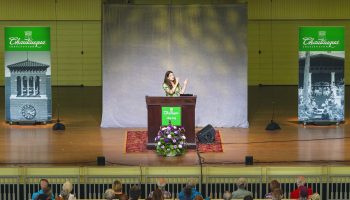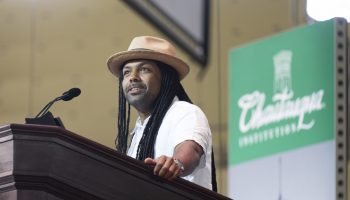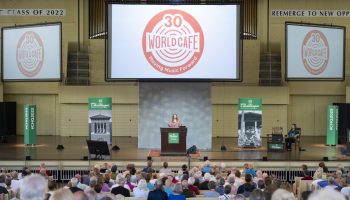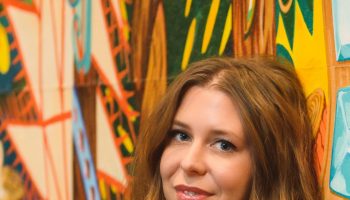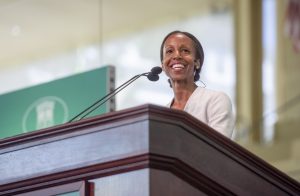
When Charles Black Jr. was 16 years old, he went to a dance at the Driskill Hotel in Austin, Texas. It was there that, instead of socializing with young women as he intended to do, Black became so transfixed by one trumpet-player that he would later describe the performance as an encounter with “genius.”
The man he saw perform that night was Louis Armstrong, and Black — who would join the legal team of the 1954 Brown v. Board of Education case, as well as become one of the preeminent constitutional lawyers of the United States — cited that evening at the Driskill Hotel as the day he “began walking toward the Brown case, where (he) belonged.”
Sarah Lewis, an award-winning scholar, best-selling author, and professor at Harvard University, offered this anecdote during her 10:45 a.m. Tuesday lecture in the Amphitheater as an example of “what aesthetic force can do.” For the second morning lecture in a week titled “Exploring Race and Culture with Wynton Marsalis and Jazz at Lincoln Center,” Lewis distilled for the Amp audience the “Vision & Justice” course she teaches at Harvard — a class that the school incorporated into its core curriculum after the Aperture issue of the same name, guest edited by Lewis, garnered nationwide acclaim in 2016.
Among the individuals Lewis thanked at the beginning of her lecture — including a former Harvard student who attended the talk even though, as Lewis noted, he is “not being graded anymore” — was her grandfather Shadrach Emmanuel Lee. As a junior at a Brooklyn public high school in 1926, Lee asked his teacher why the representations of excellence that filled his history textbooks were exclusively white. His teacher told him that African Americans had accomplished nothing to warrant their inclusion. Lee refused to accept that answer, and was later expelled for “impertinence” after asking again and again.
“He went on to become a jazz musician, playing bass, and a painter,” Lewis said. “And here I am, two generations later, teaching at Harvard University about the very topics that he was expelled for asking about. I’d like to just think it’s a testament to what is still possible in this country.”
Images are integral to the affirmation of humanity’s dignity, Lewis argued, adopting the framework her grandfather employed in the early 20th century. She recalled a question a Chautauquan had asked Wynton Marsalis during the question-and-answer period after Marsalis’ 10:45 a.m. lecture on Monday in the Amp: “At the age of 70, what can we do to improve this country, besides voting and donating?”
After acknowledging that both voting and donating are important acts of citizenship, Lewis introduced another action the audience could perform in the service of racial justice and freedom in the United States — “To question what you see, why you see it, and what it means.”
“I’m going to ask you to do this because we are in an urgent, almost perilous moment,” Lewis said. “This country has been in such moments before, yet this particular one has a distinct character. It offers near-daily reminders that the fragility of American rights has not only been secured by norms and laws, but by how we judge — how we quite literally see each other. And how we refuse to see each other.”
Art can help overcome “the blind spot around our privilege shaped exactly like us,” Lewis said, by not only illuminating “what we already know,” but also “what we don’t know we don’t know.” This was the central question of a trip Lewis and her students took to Washington, D.C. In preparation for their visit, which included a tour of the Capitol Rotunda, Lewis showed her students a short clip in which a diverse group of Americans read an excerpt of the Declaration of Independence. The video reveals that each person gathered in that room is a living descendant of one of the original Declaration signers, all of whom were white men. It pauses on the still of these contemporary Americans positioned like their ancestors in John Trumbull’s 1818 painting “Declaration of Independence.” The image, in Lewis’ words, looks like “the world has rushed in.”
Around the time of the creation of this painting — one of the pieces currently showcased in the Rotunda — citizenship necessitated that one had to be white, male and own property.
“What is the definition of the journey between 1790, and the current day?” Lewis asked. “Has the enlargement of the idea of citizenship — of who counts and who belongs — just been a legal narrative, a series of amendments? Or has it been a cultural one?”
As an art historian, Lewis admitted her bias for the latter portrayal, and spent the remainder of her lecture arguing for culture’s role in determining the “health” of a representative democracy.
“Representative democracy has also meant measuring life through representation itself,” Lewis said. “What we put on stages becomes our collective currency to assess who we are.”
She characterized the story of Black and Armstrong as an example of art as a catalyst for justice, and the detailed plan of a 17th century slave ship, “Description Of A Slave Ship,” as “evidentiary proof of slavery’s inhumanity.” NASA and William Anders’ 1968 photograph, “Earthrise,” helped galvanize the environmental movement by “(having) enough coalescing force to do what rational argument alone could not.”
In December 1861, Frederick Douglass — who was the most photographed man of the 19th century — made the case for the role of images in advancing society. At the beginning of the Civil War, an age during which the new science of photography was weaponized to cement racial hierarchies, Douglass contended that it is inside the gap between “the fact of life” and “the ideal” where “moral imagination” can emerge.
By sitting for photographs, Douglass “was subverting the stereotypes that were being hardened through these images with his own body,” Lewis said. According to her, he is “one of the earliest art historians focused on racial justice in this country.”
Martin Luther King Jr. was an artist too, Lewis claimed, as she shared a copy of his seminary transcript, which documents the C+ and C grades King received for two public speaking classes.
“It occurred to me that we would be nowhere in this country without the power of the arts to overcome collective failure,” she said. “And here, of course, the arts include the power of oratory and the style, distinctive as it was in the body of King.”
In 2015, the photography magazine Aperture asked Lewis to guest edit an issue. Initially, she declined. She agreed when Aperture allowed her “to focus on this understudied nexus of vision and justice.”
“The centuries-long effort to craft an image, to give honor to the full humanity of black life is, in and of itself, a corrective task for which, as Douglass knew, the camera has been central — even indispensable,” Lewis said, before exhibiting a few chosen images from the Infinity Prize-winning issue, including Awol Erizku’s “Girl with the Bamboo Earring” and photos by Pete Souza, chief official White House photographer for President Barack Obama.
“Understanding that relationship of race and the quest for full citizenship in this country requires an advanced state of literacy,” Lewis said. “It’s especially important today as we’ve been able to witness injustices in a firsthand fashion on a massive scale, via technology that would have been unimaginable decades ago.”
The viral dissemination of Eric Garner’s 2014 killing by a New York City Police Department officer, as well as Dylann Roof’s self-styled portraits before murdering nine African Americans at Emanuel African Methodist Episcopal Church, are significant spaces of potential visual analyses, Lewis said. Such considerations become all the more important, she argued, when we know that every two minutes, Americans alone take more photographs than were made in the entire 19th century.
“How many went to Selma because they were moved by an image of injustice on the television?” Lewis asked. “How many figures like Charles Black Jr. were struck still by the power of the arts to deliver a message that rational argument could not?”
Turning to art censored by the U.S. government as a testament to the image’s capacity to inform society, Lewis displayed photographs that chronicled the internment of Japanese Americans. One, a 1942 photograph by Dorothea Lange, framed a large sign placed in the window of a store. The sign reads, in all caps, “I am an American.” The store belonged to Tatsuro Matsuda, a man forced to evacuate Oakland, California, as a result of Executive Order 9066.
“Although the sign was hung as a public plea to his neighbors, the empty street suggests that no one was listening,” Lewis said, reading from a short essay one of her students wrote about the photograph. “The photograph’s impartiality mimics the distance between former neighbors and fellow citizens. The sign, too, functions as a memorial — what was once a proud statement of presence, of ‘I Am,’ now becomes a somber lesson in the futility of Japanese Americans’ fight for citizenship.”
In the final portion of her lecture, Lewis shared images of Thomas Crawford’s sculpture, “The Indian: The Dying Chief Contemplating the Progress of Civilization,” and a wall of jars of soil — an aspect of The National Memorial for Peace and Justice — that honors victims of lynching in every county in Alabama. Circling back to her field trip to D.C., Lewis spoke about standing at the Martin Luther King Jr. Memorial and looking out to see the Thomas Jefferson Memorial in the distance.
“My colleague Tina Campt reminds us that, in the context of race, possibility comes with an examination not just of the future tense — ‘what will be’ — or even the future perfect tense — ‘that which will have happened’ — but what she refers to as the future real conditional — ‘that which will have had to have happened,’ ” Lewis said. “It is, as she argues, an orientation towards ‘what should be true.’ It involves living the future as an imperative, rather than a subjunctive. As a striving for the future you want to see right now, in the present.”
To conclude, Lewis played a video created by her students — a series of images set to a recording of John F. Kennedy’s eulogy for Robert Frost, a speech that is often titled “Power and Poetry.”
“I look forward to an America which will steadily raise the standards of artistic accomplishment and which will steadily enlarge cultural opportunities for all of our citizens,” Kennedy narrated, as photographs of James Baldwin and Serena Williams flashed on the screen. “And I look forward to an America which commands respect throughout the world — not only for its strength, but for its civilization as well. And I look forward to a world which will be safe not only for democracy and diversity, but also for personal distinction.”

